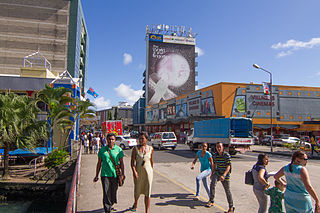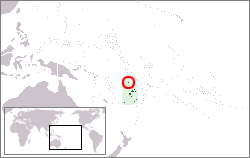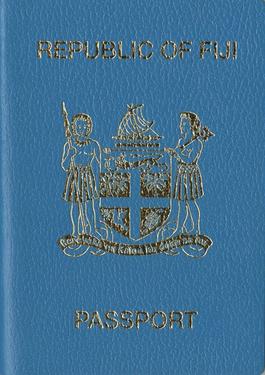Related Research Articles

Fiji, officially the Republic of Fiji, is an island country in Melanesia, part of Oceania in the South Pacific Ocean. It lies about 1,100 nautical miles north-northeast of New Zealand. Fiji consists of an archipelago of more than 330 islands—of which about 110 are permanently inhabited—and more than 500 islets, amounting to a total land area of about 18,300 square kilometres (7,100 sq mi). The most outlying island group is Ono-i-Lau. About 87% of the total population of 924,610 live on the two major islands, Viti Levu and Vanua Levu. About three-quarters of Fijians live on Viti Levu's coasts, either in the capital city of Suva, or in smaller urban centres such as Nadi or Lautoka. The interior of Viti Levu is sparsely inhabited because of its terrain.

Suva is the capital and largest city of Fiji. It is the home of the country's largest metropolitan area and serves as its major port. The city is located on the southeast coast of the island of Viti Levu, in Rewa Province, Central Division.

Melanesia is a subregion of Oceania in the southwestern Pacific Ocean. It extends from New Guinea in the west to the Fiji Islands in the east, and includes the Arafura Sea.

Rotuma is a self-governing heptarchy, generally designated a dependency of Fiji. 'Rotuma' commonly refers to Rotuma Island, the only permanently inhabited and by far the largest of all the islands in the Rotuma Group. Officially, the Rotuma Act declares that Rotuma consists of Rotuma Island as well as its neighbouring islands, rocks, and reefs across the entire Rotuma Group. The dependency is situated around 500 km west of the French islands of Wallis and Futuna and a similar distance north of the Fijian mainland. Its capital is Ahau, a hamlet consisting of a number of colonial-era buildings. Rotuma exists as a dependency of Fiji but itself contains its own sociocultural enclave known traditionally as Faguta. Composed of the districts of Juju and Pepjei, Faguta and its inhabitants have a unique identity reflected in Marist practices of worship, French orthography for written Rotuman and a specific set of dates for the Fara festival. Faguta's special character was effectively agreed to by all Rotuma's chiefs in 1871 in the Treaty of Hamelin.

The Pacific Islands Forum (PIF) is an inter-governmental organization that aims to enhance cooperation between countries and territories of Oceania, including formation of a trade bloc and regional peacekeeping operations. It was founded in 1971 as the South Pacific Forum (SPF), and changed its name in 1999 to "Pacific Islands Forum", so as to be more inclusive of the Forum's Oceania-spanning membership of both north and south Pacific island countries, including Australia. It is a United Nations General Assembly observer.

Nadi is the third-largest conurbation in Fiji. It is located on the western side of the main island of Viti Levu, and had a population of 42,284 at the most recent census, in 2007. A 2012 estimate showed that the population had grown to over 50,000. Nadi is multiracial with many of its inhabitants Asians, Indian or Indigenous Fijians, along with a large transient population of foreign tourists. Along with sugar cane production, tourism is a mainstay of the local economy.

The national flag of Fiji was adopted on 10 October 1970. The state arms have been slightly modified but the flag has remained the same as during Fiji's colonial period. It is a defaced cyan "Blue Ensign", with the shield from the national coat of arms. It has remained unchanged since Fiji was declared a republic in 1987, despite calls from some politicians for changes.
Fiji Airways is the flag carrier of Fiji and operates international services from its hubs in Fiji to 15 countries and 27 cities including, Australia, New Zealand, Samoa, Tonga, Tuvalu, Kiribati, Vanuatu and Solomon Islands (Oceania), Hong Kong, Japan, Singapore, Canada and the United States. It has an extended network of 108 international destinations through its codeshare partners. The Fiji Airways Group brings in 64 percent of all visitors who fly to Fiji, employs over 1000 employees, and earns revenues of over FJD$815 million (US$390m).
Fijians are a nation and ethnic group native to Fiji, who speak Fijian and English and share a common history and culture.

Vanua Levu formerly known as Sandalwood Island, is the second largest island of Fiji. Located 64 kilometres to the north of the larger Viti Levu, the island has an area of 5,587.1 square kilometres (2,157.2 sq mi) and a population of 135,961 as of 2007.

Viti Levu is the largest island in the Republic of Fiji. It is the site of the nation's capital, Suva, and home to a large majority of Fiji's population.

The Fiji men's national football team is Fiji's national men's team and is controlled by the governing body of football in Fiji, the Fiji Football Association. The team plays most of their home games at the HFC Bank Stadium in Suva.
The culture of Fiji is a tapestry of native Fijian, Indian, European, Chinese, and other nationalities. Culture polity traditions, language, food costume, belief system, architecture, arts, craft, music, dance, and sports will be discussed in this article to give you an indication of Fiji's indigenous community but also the various communities which make up Fiji as a modern culture and living. The indigenous culture is an active and living part of everyday life for the majority of the population.

Taveuni is the third-largest island in Fiji, after Viti Levu and Vanua Levu, with a total land area of 434 square kilometres. The cigar-shaped island, a massive shield volcano which rises from the floor of the Pacific Ocean, is situated 6.5 kilometres east of Vanua Levu, across the Somosomo Strait. It belongs to the Vanua Levu Group of islands and is part of Fiji's Cakaudrove Province within the Northern Division.
The Lau Islands of Fiji are situated in the southern Pacific Ocean, just east of the Koro Sea. Of this chain of about sixty islands and islets, about thirty are inhabited. The Lau Group covers a land area of 188 square miles, and had a population of 10,683 at the most recent census in 2007. While most of the northern Lau Group are high islands of volcanic origin, those of the south are mostly carbonate low islands.

The 180th meridian or antimeridian is the meridian 180° both east and west of the prime meridian in a geographical coordinate system. The longitude at this line can be given as either east or west.

Drua, also known as na drua, n'drua, ndrua or waqa tabu, is a double-hull sailing boat that originated in the south-western Pacific islands. Druas do not tack but rather shunt. Both ends of each hull are identical, but the hulls are of different sizes and the smaller one is always sailed to windward. The main differences, compared to proas, are that the hulls have a symmetric U-form profile, and a second hull is used instead of an outrigger. When a float (cama) is used in place of the smaller hull, the craft is called a camakau.
The Fijian double canoe was the largest and finest sea-going vessel ever designed and built by natives of Oceania before contact with Europeans.
The history of the Jews in Fiji is intertwined with the settlement of the Fiji islands by European explorers and settlers. Most of these settlers arrive in Fiji via Australia and New Zealand.
Fiji has three official languages under the 1997 constitution : English, Fijian and Fiji Hindi. The Fijian language is spoken as the first language by most indigenous Fijians who make up around 54% of the population.

Fijian passports are issued to citizens of Fiji by the Passport Division of the Department of Immigration, under the ambits of the Fiji Islands Passports Act 2002.
References
- ↑ Myths and legends of Fiji and Rotuma by Alexander Wyclif Reed and Alice Inez Hames. "The stories of Fiji are rich in drama, telling of gods and fabulous creatures, of islands built by supernatural powers, and of the creation of the birds, beasts and plants that inhabit the islands that make up the Fijian group."